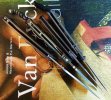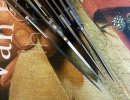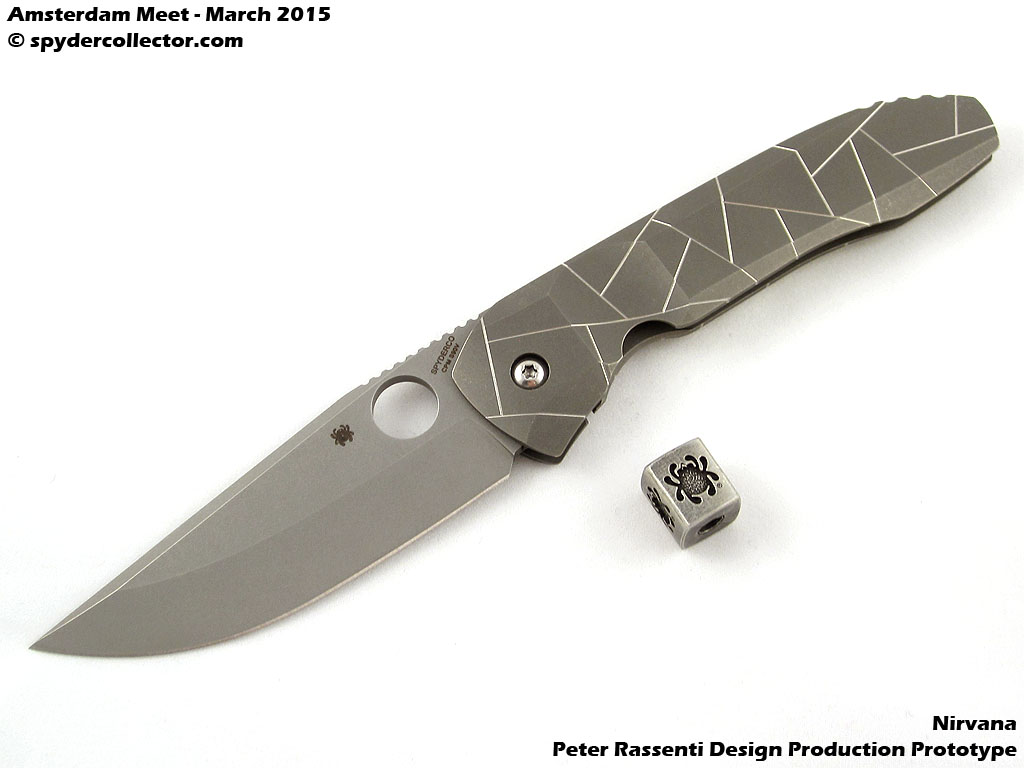- Joined
- Aug 30, 2014
- Messages
- 1,097
The Slysz Bowie just arrived in my mailbox, and I haven't been this impressed with a Spyderco since... well, ever. I'm a fan of the Taiwanese models, but the Southard, despite being a beautifully made knife with one of the best steels available and excellent fit and finish, just didn't work for me in terms of ergonomics. I prefer larger knives, so when the K2 and the Slysz Bowie came out, and a marketplace seller on Amazon.ca was selling the K2 for the ridiculously low price of 210$ Canadian (about 175$ USD), I didn't hesitate. The K2 is an awesome knife, with a huge CPM 10V blade that is razor sharp; it spyder-flicks open with a smooth, easy action, and has very nice stonewashed titanium and a unique faux-spherical polished standoff. But it's an eccentric design, to say the least, over 10-inches long but thinner than a Sebenza, only vaguely ergonomic, and with an eternally sticky lockbar that requires injecting steroids into your thumb to close (I'm kidding, obviously, it's not all that bad now that it's broken in after a few weeks; but it still sticks, and all the graphite in the world won't stop it... on the positive, it is an incredibly secure lock-up -- about 80%, due to the thinness of the profile and the tension on the lockbar).
While I do really love the K2, in all its massive, oddball glory, the Slysz Bowie hasn't required the same kind of parent-like unconditional acceptance. It's a virtually perfect knife. An excellent video by Solo's Knife Reviews pointed out the two minor questions related to the design -- a flat surface on the tang connecting with a round stop-pin, and thicker-than-usual bronze washers. Given how silky smooth the action was on mine out of the box (Sebenza smooth, without the grease!), I've already decided the washers are a positive, and the tolerances are pretty tight anyway. As for the former, while a rounded notch might have been better, or a flat-faced, D-shaped stop-pin, I don't think the pin is likely to flatten (creating theoretical up and down blade-play in the lock-up) any time soon. Even if it did, I don't see why I couldn't simply spin the stop-pin 90-180 degrees so it could hypothetically start flattening the other side. After those two minor-to-non-existent concerns, there's nothing to criticize. I would have preferred CTS-204P, I guess, but CTS-XHP is purportedly an excellent steel as well, a lower vanadium alternative to CPM S30V, S35VN, or Elmax. Like CPM Cruwear, PSF 27, Sleipner, and many other steels, XHP has been compared to D2 (or CPM D2, since XHP uses Carpenter's version of particle metallurgical technology), with better corrosion resistance. I've also heard it tastes like chicken.
The fit and finish on the Slysz is truly impressive. The Spyderco full-flat grind and long, distal taper are combined with a beautiful stone-washed finish; it has what looks like a transparent protective layer of something like cerakote (virtually identical to the Southard's stone-washed finish), giving it a glassy smooth texture that no doubt contributes to the smooth action as well. The blade spine has fairly 'passive' jimping (as opposed to aggressive jimping), but it does provide some traction when heavy pressure is applied. The jimping on the stylish G-10 backspacer, on the other hand, is very functional with minimal pressure, helping to offset the untextured ti surface. About an inch-and-a-quarter past the handle, the gentle angle of the Bowie profile leading to the point has been flawlessly radiused, a touch I particularly like. The stone-washed blade has been matched with stone-washed titanium handle scales, and the Taichung factory has once again nailed the details. While it looked similar to the K2 when I first saw them, the Slysz is a completely different species, expertly refined to justify the higher price. The contoured titanium, in contrast to the flat scales of the Farid Mehr design, is an expensive feature that only knife aficionados are likely to appreciate, and the same can be said for much of this knife's finer points. The lock-up is perfect, and unlike the K2, there isn't the faintest trace of stickiness. If comparisons are going to be made, the Slysz Bowie is clearly emulating the Sebenza, and doing a damn fine job. It might not be quite as good as Chris Reeve's crowning achievement, but at 55-60% the price, it is most assuredly 55-60% as good... maybe even 70%. That's high praise, I know, but I think it's justified.




While I do really love the K2, in all its massive, oddball glory, the Slysz Bowie hasn't required the same kind of parent-like unconditional acceptance. It's a virtually perfect knife. An excellent video by Solo's Knife Reviews pointed out the two minor questions related to the design -- a flat surface on the tang connecting with a round stop-pin, and thicker-than-usual bronze washers. Given how silky smooth the action was on mine out of the box (Sebenza smooth, without the grease!), I've already decided the washers are a positive, and the tolerances are pretty tight anyway. As for the former, while a rounded notch might have been better, or a flat-faced, D-shaped stop-pin, I don't think the pin is likely to flatten (creating theoretical up and down blade-play in the lock-up) any time soon. Even if it did, I don't see why I couldn't simply spin the stop-pin 90-180 degrees so it could hypothetically start flattening the other side. After those two minor-to-non-existent concerns, there's nothing to criticize. I would have preferred CTS-204P, I guess, but CTS-XHP is purportedly an excellent steel as well, a lower vanadium alternative to CPM S30V, S35VN, or Elmax. Like CPM Cruwear, PSF 27, Sleipner, and many other steels, XHP has been compared to D2 (or CPM D2, since XHP uses Carpenter's version of particle metallurgical technology), with better corrosion resistance. I've also heard it tastes like chicken.
The fit and finish on the Slysz is truly impressive. The Spyderco full-flat grind and long, distal taper are combined with a beautiful stone-washed finish; it has what looks like a transparent protective layer of something like cerakote (virtually identical to the Southard's stone-washed finish), giving it a glassy smooth texture that no doubt contributes to the smooth action as well. The blade spine has fairly 'passive' jimping (as opposed to aggressive jimping), but it does provide some traction when heavy pressure is applied. The jimping on the stylish G-10 backspacer, on the other hand, is very functional with minimal pressure, helping to offset the untextured ti surface. About an inch-and-a-quarter past the handle, the gentle angle of the Bowie profile leading to the point has been flawlessly radiused, a touch I particularly like. The stone-washed blade has been matched with stone-washed titanium handle scales, and the Taichung factory has once again nailed the details. While it looked similar to the K2 when I first saw them, the Slysz is a completely different species, expertly refined to justify the higher price. The contoured titanium, in contrast to the flat scales of the Farid Mehr design, is an expensive feature that only knife aficionados are likely to appreciate, and the same can be said for much of this knife's finer points. The lock-up is perfect, and unlike the K2, there isn't the faintest trace of stickiness. If comparisons are going to be made, the Slysz Bowie is clearly emulating the Sebenza, and doing a damn fine job. It might not be quite as good as Chris Reeve's crowning achievement, but at 55-60% the price, it is most assuredly 55-60% as good... maybe even 70%. That's high praise, I know, but I think it's justified.




Last edited:



